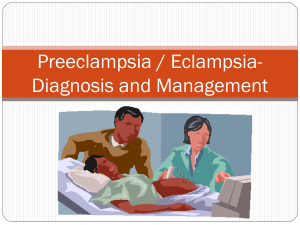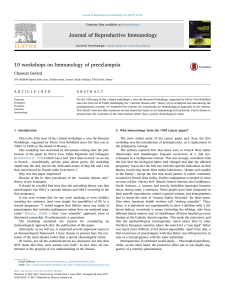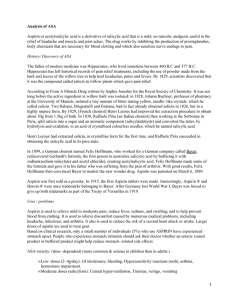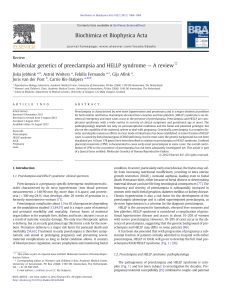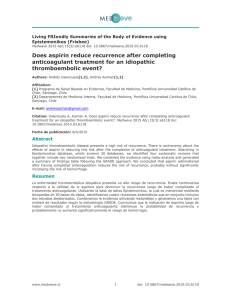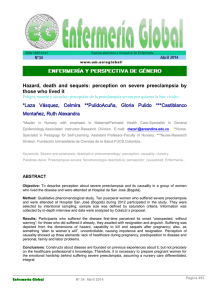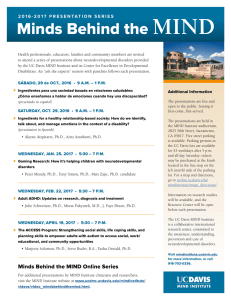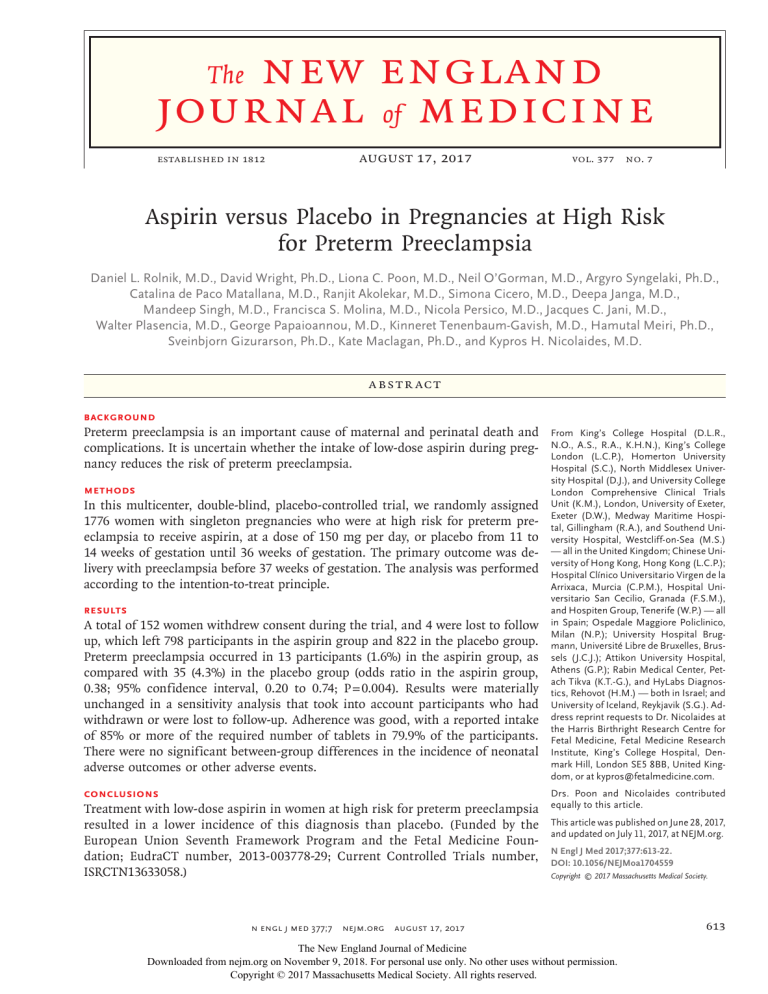
new england journal of medicine The established in 1812 August 17, 2017 vol. 377 no. 7 Aspirin versus Placebo in Pregnancies at High Risk for Preterm Preeclampsia Daniel L. Rolnik, M.D., David Wright, Ph.D., Liona C. Poon, M.D., Neil O’Gorman, M.D., Argyro Syngelaki, Ph.D., Catalina de Paco Matallana, M.D., Ranjit Akolekar, M.D., Simona Cicero, M.D., Deepa Janga, M.D., Mandeep Singh, M.D., Francisca S. Molina, M.D., Nicola Persico, M.D., Jacques C. Jani, M.D., Walter Plasencia, M.D., George Papaioannou, M.D., Kinneret Tenenbaum‑Gavish, M.D., Hamutal Meiri, Ph.D., Sveinbjorn Gizurarson, Ph.D., Kate Maclagan, Ph.D., and Kypros H. Nicolaides, M.D. a bs t r ac t BACKGROUND Preterm preeclampsia is an important cause of maternal and perinatal death and complications. It is uncertain whether the intake of low-dose aspirin during pregnancy reduces the risk of preterm preeclampsia. METHODS In this multicenter, double-blind, placebo-controlled trial, we randomly assigned 1776 women with singleton pregnancies who were at high risk for preterm preeclampsia to receive aspirin, at a dose of 150 mg per day, or placebo from 11 to 14 weeks of gestation until 36 weeks of gestation. The primary outcome was delivery with preeclampsia before 37 weeks of gestation. The analysis was performed according to the intention-to-treat principle. RESULTS A total of 152 women withdrew consent during the trial, and 4 were lost to follow up, which left 798 participants in the aspirin group and 822 in the placebo group. Preterm preeclampsia occurred in 13 participants (1.6%) in the aspirin group, as compared with 35 (4.3%) in the placebo group (odds ratio in the aspirin group, 0.38; 95% confidence interval, 0.20 to 0.74; P = 0.004). Results were materially unchanged in a sensitivity analysis that took into account participants who had withdrawn or were lost to follow-up. Adherence was good, with a reported intake of 85% or more of the required number of tablets in 79.9% of the participants. There were no significant between-group differences in the incidence of neonatal adverse outcomes or other adverse events. CONCLUSIONS Treatment with low-dose aspirin in women at high risk for preterm preeclampsia resulted in a lower incidence of this diagnosis than placebo. (Funded by the European Union Seventh Framework Program and the Fetal Medicine Foun­ dation; EudraCT number, 2013-003778-29; Current Controlled Trials number, ISRCTN13633058.) n engl j med 377;7 nejm.org From King’s College Hospital (D.L.R., N.O., A.S., R.A., K.H.N.), King’s College London (L.C.P.), Homerton University Hospital (S.C.), North Middlesex University Hospital (D.J.), and University College London Comprehensive Clinical Trials Unit (K.M.), London, University of Exeter, Exeter (D.W.), Medway Maritime Hospital, Gillingham (R.A.), and Southend University Hospital, Westcliff-on-Sea (M.S.) — all in the United Kingdom; Chinese University of Hong Kong, Hong Kong (L.C.P.); Hospital Clínico Universitario Virgen de la Arrixaca, Murcia (C.P.M.), Hospital Universitario San Cecilio, Granada (F.S.M.), and Hospiten Group, Tenerife (W.P.) — all in Spain; Ospedale Maggiore Policlinico, Milan (N.P.); University Hospital Brugmann, Université Libre de Bruxelles, Brussels (J.C.J.); Attikon University Hospital, Athens (G.P.); Rabin Medical Center, Petach Tikva (K.T.-G.), and HyLabs Diagnostics, Rehovot (H.M.) — both in Israel; and University of Iceland, Reykjavik (S.G.). Address reprint requests to Dr. Nicolaides at the Harris Birthright Research Centre for Fetal Medicine, Fetal Medicine Research Institute, King’s College Hospital, Denmark Hill, London SE5 8BB, United Kingdom, or at ­k ypros@­fetalmedicine.­com. Drs. Poon and Nicolaides contributed equally to this article. This article was published on June 28, 2017, and updated on July 11, 2017, at NEJM.org. N Engl J Med 2017;377:613-22. DOI: 10.1056/NEJMoa1704559 Copyrightº © 2017 Massachusetts Medical Society. August 17, 2017 The New England Journal of Medicine Downloaded from nejm.org on November 9, 2018. For personal use only. No other uses without permission. Copyright © 2017 Massachusetts Medical Society. All rights reserved. 613 The n e w e ng l a n d j o u r na l P A Quick Take is available at NEJM.org 614 reeclampsia is an important cause of death and complications for the mother and baby. The risk of such complications is considerably higher when the disease is severe and of early onset, leading to preterm birth at less than 37 weeks of gestation.1-4 Major challenges in modern obstetrics are the identification of women at high risk for preterm preeclampsia early in pregnancy and interventions to reduce the prevalence of the disease. In 1979, a study showed that women who had taken aspirin regularly during pregnancy were less likely to have preeclampsia than women who had not.5 In the subsequent decades, more than 30 trials have investigated the benefit of lowdose aspirin (at a dose of 50 to 150 mg per day) for the prevention of preeclampsia; a meta-analysis of these studies showed that such therapy resulted in a 10% lower incidence of preeclampsia.6 In a meta-analysis of individual-participant data from the trials, the effect of aspirin was not affected by the gestational age at the onset of therapy.7 In contrast, other meta-analyses showed that aspirin started at or before 16 weeks of gestation resulted in halving the rates of preeclampsia, fetal-growth restriction, and perinatal death, whereas aspirin started after 16 weeks of gestation did not have a significant benefit.8,9 In addition, the beneficial effect of aspirin that was started at or before 16 weeks of gestation was dose dependent, with a greater reduction in the incidence of preeclampsia being associated with a daily dose of aspirin of 100 mg or more.10 Professional associations now recommend the prophylactic use of low-dose aspirin (60 to 80 mg per day) in women who are considered to be at high risk for preeclampsia. In the United Kingdom, the National Institute for Health and Clinical Excellence recommends the identification of the high-risk group on the basis of 10 factors, including maternal characteristics and features of the medical and obstetrical histories.11 However, the performance of such screening is poor, with detection of approximately 40% of cases of preterm preeclampsia and 33% of cases of term preeclampsia, at a screen-positive rate of 11%.12 In the United States, the American College of Obstetricians and Gynecologists recommends the use of aspirin in women with a history of preeclampsia in more than one pregnancy or a history of preeclampsia that resulted in delivery n engl j med 377;7 of m e dic i n e before 34 weeks of gestation.13 However, this subgroup constitutes only approximately 0.3% of all pregnancies and includes only 5% of women in whom preterm preeclampsia develops and 2% of those in whom term preeclampsia develops.14 An alternative approach to screening is the use of Bayes’ theorem to combine the a priori risk from maternal factors with biophysical and biochemical measurements obtained at 11 to 13 weeks of gestation. A study involving approximately 60,000 women with singleton pregnancies showed that such screening detected 76% of cases of preterm preeclampsia and 38% of cases of term preeclampsia, at a screen-positive rate of 10%.15 The Combined Multimarker Screening and Randomized Patient Treatment with Aspirin for Evidence-Based Preeclampsia Prevention (ASPRE) trial was designed to test the hypothesis that, among women who are identified as being at high risk for preterm preeclampsia on the basis of the above-mentioned factors, aspirin at a dose of 150 mg per day, taken from 11 to 14 weeks of gestation until 36 weeks of gestation, would result in an incidence of preterm preeclampsia that was half the incidence observed with placebo. Me thods Trial Design and Participants In this double-blind, placebo-controlled trial, we compared aspirin at a dose of 150 mg per day with placebo that was administered from 11 to 14 weeks of gestation until 36 weeks of gestation in women with singleton pregnancies who were at high risk for preterm preeclampsia. We conducted the trial at 13 maternity hospitals in the United Kingdom, Spain, Italy, Belgium, Greece, and Israel. All the women who had a routine prenatal visit at 11 weeks 0 days of gestation through 13 weeks 6 days of gestation in the participating hospitals were offered screening for preeclampsia by means of an algorithm that combines maternal factors, mean arterial pressure, uterine-artery pulsatility index, and maternal serum pregnancy-associated plasma protein A and placental growth factor. (The algorithm is provided in the Supplementary Appendix, available with the full text of this article at NEJM.org.)15 Gestational age was determined from the measurement of the fetal crown–rump length.16 nejm.org August 17, 2017 The New England Journal of Medicine Downloaded from nejm.org on November 9, 2018. For personal use only. No other uses without permission. Copyright © 2017 Massachusetts Medical Society. All rights reserved. Aspirin vs. Placebo for Preterm Preeclampsia Maternal characteristics and medical and obstetrical histories were recorded, and the maternal weight and height were measured. The mean arterial pressure was measured by validated automated devices with the use of a standardized protocol.17 Transabdominal color Doppler ultrasonography was used to measure the left and right uterine-artery pulsatility index, and the average value was recorded.18 Serum concentrations of pregnancy-associated plasma protein A and placental growth factor were measured by an automated device (PAPP-A and PlGF 1-2-3 kits and DELFIA Xpress random access platform, Perkin­ Elmer). Quality control was applied to achieve consistency of the measurement of biomarkers across trial centers. Quality control of screening and verification of adherence to the protocol were performed by the University College London Comprehensive Clinical Trials Unit. Inclusion criteria for the trial were the following: an age of 18 years or more, singleton pregnancy, live fetus at the time that scanning was performed at 11 to 13 weeks of gestation, and a high risk (>1 in 100) for preterm preeclampsia according to the screening algorithm. Exclusion criteria were the following: unconscious or severe­ ly ill status, learning difficulties or serious mental illness, major fetal abnormality identified at the time that scanning was performed at 11 to 13 weeks of gestation, regular treatment with aspirin within 28 days before screening, bleeding disorder such as von Willebrand’s disease, peptic ulceration, hypersensitivity to aspirin, long-term use of nonsteroidal antiinflammatory medication, and participation in another drug trial within 28 days before screening. Potential trial participants were given written information about the trial, and those who agreed to participate provided written informed consent. Approval for the trial was obtained from the relevant research ethics committee and competent authority in each country in which the trial was conducted. The trial was conducted with fidelity to the protocol, which is available, with the statistical analysis plan, at NEJM.org. The funding organizations and the companies that supplied and distributed the aspirin and placebo had no role in the trial design, the collection, analysis, or interpretation of the data, the writing of the manuscript, or the decision to submit the manuscript for publication. The authors vouch n engl j med 377;7 for the accuracy and completeness of the data and analyses. Randomization and Trial-Group Assignment Eligible women were randomly assigned, in a 1:1 ratio, with the use of a Web-based system (Sealed Envelope), to receive either aspirin or placebo, and in the random-sequence generation there was stratification according to participating center. The aspirin and placebo tablets were manufactured by Actavis UK and were packaged, labeled, stored, and distributed by Mawdsley-Brooks. The placebo tablets were identical to the aspirin tablets with respect to variables such as size, thickness, physical properties, and appearance. After randomization, the participants were prescribed the assigned trial product and received instructions to take one tablet every night throughout the trial and to stop taking tablets at 36 weeks of gestation or, in the event of early delivery, at the onset of labor. Outcome Measures The primary outcome measure was delivery with preeclampsia before 37 weeks of gestation. Preeclampsia was defined according to the International Society for the Study of Hypertension in Pregnancy (see the Supplementary Appendix).19 Secondary outcomes were adverse outcomes of pregnancy before 34 weeks of gestation, before 37 weeks of gestation, and at or after 37 weeks of gestation; stillbirth or neonatal death; death and neonatal complications; neonatal therapy; and poor fetal growth (birth weight below the 3rd, 5th, or 10th percentile) (Table S1 in the Supplementary Appendix).20 Adverse Events and Adherence Adverse events and adherence were assessed and recorded at follow-up clinical visits at 19 to 24 weeks of gestation, 32 to 34 weeks of gestation, and 36 weeks of gestation and during three telephone interviews, which occurred at 16 weeks and 28 weeks of gestation and 30 days after the last tablet was taken. Participants were encouraged to record any side effects or adverse events in a diary that was reviewed at each trial visit, and they were specifically asked about such events during each telephone interview. We assessed adherence by counting the tablets that were returned by participants at each nejm.org August 17, 2017 The New England Journal of Medicine Downloaded from nejm.org on November 9, 2018. For personal use only. No other uses without permission. Copyright © 2017 Massachusetts Medical Society. All rights reserved. 615 The n e w e ng l a n d j o u r na l visit and by the participants’ reporting of tablet counts during each telephone interview. The total number of tablets taken was calculated by subtracting the number of tablets returned from the number of tablets prescribed. Adherence was considered to be good if the reported intake of tablets was 85% or more of the total number that participants were expected to have taken between the date of randomization and the date of the visit at 36 weeks of gestation or the date of delivery if delivery occurred before 36 weeks of gestation. Adherence was considered to be moderate if the intake was between 50% and 84.9% and considered to be poor if it was less than 50%. Statistical Analysis The sample-size estimation was based on the assumption that first-trimester screening would detect 76% of the cases of preterm preeclampsia at a screen-positive rate of 10%.15 It was hypothesized that low-dose aspirin would result in a rate of preterm preeclampsia that was 50% lower than the rate with placebo,8,9 for an estimated rate of 7.6% in the placebo group and 3.8% in the aspirin group. We calculated that the enrollment of 1600 participants would give the trial 90% power to show a treatment effect at a twosided alpha level of 5%. The target recruitment number was inflated to 1776 to account for attrition. Statistical analyses were performed on an intention-to-treat basis, and no interim analyses were performed. Logistic-regression analysis was used to determine the significance of the betweengroup difference in the incidence of preterm preeclampsia, with adjustment for the effect of the estimated risk of preeclampsia at screening and the participating center. The treatment effect was quantified as the odds ratio with a 95% confidence interval in the aspirin group. Prespecified analyses were also performed in subgroups that were categorized according to the estimated risk of preterm preeclampsia and history of preeclampsia; a post hoc subgroup analysis was performed according to country of the participating centers. A sensitivity analysis was performed to take into account the effect of withdrawal of consent and loss to follow-up. We also produced Kaplan–Meier estimates of the cumulative incidence of preeclampsia according 616 n engl j med 377;7 of m e dic i n e to trial group, in which deliveries that were not with preeclampsia were excluded. The treatment effect for the secondary outcomes was quantified as the odds ratio with a 99% confidence interval in the aspirin group, with adjustment for the effect of the estimated risk for preeclampsia at screening and the participating center, and no corrections were made for multiple comparisons. The statistical software package R was used for data analyses.21 R e sult s Trial Participants The trial started at King’s College Hospital, in the United Kingdom, in April 2014 but was stopped in June 2014 after the recruitment of 56 participants because of administrative problems with the supply of the trial products. The manufacture and composition of the products were the same throughout the trial, and the women who were enrolled during this period were included in the trial population. The trial was restarted in July 2015, and recruitment was completed in April 2016. A total of 26,941 women with singleton pregnancies underwent screening,15 and 2971 (11.0%) were found to be at high risk for preterm preeclampsia. However, 332 of these women (11.2%) were excluded from recruitment to the trial because they did not fulfill the eligibility criteria (Fig. 1). Of the 2641 eligible women, 1776 (67.2%) agreed to participate in the trial. After randomization, 152 women (8.6%) withdrew consent. Of the women who participated in the trial, 4 were lost to follow-up. There were no significant differences between the aspirin group and the placebo group with regard to the characteristics of the participants at baseline (Table 1). In the aspirin group, there were 11 miscarriages before 24 weeks of ges­ tation, 2 pregnancy terminations for fetal abnormalities at or before 24 weeks of gestation, 1 pregnancy termination for severe fetal growth restriction and preeclampsia at 24 weeks of gestation, 7 stillbirths at or after 24 weeks of gestation, 1 neonatal death within 28 days after birth, and 776 live births of infants who survived until discharge from the hospital. In the placebo group, there were 12 miscarriages before 24 weeks of gestation, 4 pregnancy terminations for fetal nejm.org August 17, 2017 The New England Journal of Medicine Downloaded from nejm.org on November 9, 2018. For personal use only. No other uses without permission. Copyright © 2017 Massachusetts Medical Society. All rights reserved. Aspirin vs. Placebo for Preterm Preeclampsia 26,941 Women were screened for preterm preeclampsia 2971 (11.0%) Were at high risk for preterm preeclampsia 332 Were excluded 253 Were receiving aspirin 47 Had hypersensitivity to aspirin 17 Had peptic ulcer or bleeding disorder 10 Participated in another drug trial 2 Had miscarriage before randomization 3 Had termination of pregnancy before randomization 2641 Were eligible for inclusion 865 Declined to participate 1776 Underwent randomization 878 Were assigned to receive aspirin 898 Were assigned to receive placebo 74 Withdrew consent 2 Were lost to follow-up 78 Withdrew consent 2 Were lost to follow-up 798 Were included in the primary analysis 822 Were included in the primary analysis Figure 1. Screening, Randomization, and Follow-up. abnormalities at or before 24 weeks of gestation, no pregnancy terminations for severe fetal growth restriction and preeclampsia at 24 weeks of gestation, 12 stillbirths at or after 24 weeks of gestation, 2 neonatal deaths within 28 days after birth, and 792 live births of infants who survived to discharge from the hospital. Primary Outcome Preterm preeclampsia occurred in 13 of 798 participants (1.6%) in the aspirin group, as compared with 35 of 822 (4.3%) in the placebo group (adjusted odds ratio in the aspirin group, 0.38; 95% confidence interval, 0.20 to 0.74; P = 0.004) (Ta- n engl j med 377;7 ble 2). The size of the treatment effect was consistent across estimated risk groups at the time of screening, across groups defined according to obstetrical history, and across countries of the participating centers (Figs. S1 and S2 in the Supplementary Appendix). The cumulative percentages of participants who had delivery with preeclampsia are shown in Figure 2. Of the 152 women who withdrew consent, 74 did not want any of their data to be reported and 78 allowed reporting of their screening data; the baseline characteristics of the women who withdrew consent were similar between those assigned to receive aspirin and those assigned to nejm.org August 17, 2017 The New England Journal of Medicine Downloaded from nejm.org on November 9, 2018. For personal use only. No other uses without permission. Copyright © 2017 Massachusetts Medical Society. All rights reserved. 617 The n e w e ng l a n d j o u r na l of m e dic i n e Table 1. Characteristics of the Trial Participants.* Characteristic Aspirin Group (N = 798) Placebo Group (N = 822) 12.7 12.6 12.3–13.1 12.3–13.0 Gestational age at randomization — wk Median Interquartile range Age — yr Median 31.5 31.4 27.3–35.8 26.9–35.8 26.7 26.5 23.3–31.1 23.0–31.5 White 528 (66.2) 559 (68.0) Black 208 (26.1) 201 (24.5) Interquartile range Body-mass index† Median Interquartile range Race or ethnic group — no. (%)‡ South Asian 37 (4.6) 37 (4.5) East Asian 13 (1.6) 16 (1.9) Mixed race 12 (1.5) 9 (1.1) 747 (93.6) 779 (94.8) Method of conception — no. (%) Natural Assisted by use of ovulation drugs In vitro fertilization 6 (0.8) 7 (0.9) 45 (5.6) 36 (4.4) Cigarette smoking — no. (%) 57 (7.1) 59 (7.2) Mother had preeclampsia — no. (%) 66 (8.3) 74 (9.0) 49 (6.1) 61 (7.4) Medical history — no. (%) Chronic hypertension Systemic lupus erythematosus 3 (0.4) 1 (0.1) Antiphospholipid syndrome 2 (0.3) 2 (0.2) Diabetes mellitus type 1 7 (0.9) 2 (0.2) Diabetes mellitus type 2 8 (1.0) 8 (1.0) Nulliparous 547 (68.5) 543 (66.1) Multiparous without preeclampsia 164 (20.6) 195 (23.7) 87 (10.9) 84 (10.2) Obstetrical history — no. (%) Multiparous with preeclampsia Interval from last pregnancy — yr Median Interquartile range Gestational age at delivery of last pregnancy — wk Risk of preterm preeclampsia as assessed at screening at 11–13 wk (95% CI) — %§ 4.2 4.6 2.5–7.0 2.9–7.5 39 (37–40) 39 (36–40) 2.3 (1.4–4.8) 2.6 (1.5–4.8) *There were no significant between-group differences with regard to the characteristics at baseline. CI denotes confidence interval. †The body-mass index is the weight in kilograms divided by the square of the height in meters. ‡Race or ethnic group was reported by the participants. §The risk of preterm preeclampsia was assessed by means of an algorithm that combined maternal factors, mean arterial pressure, uterine-artery pulsatility index, and maternal serum pregnancy-associated plasma protein A and placental growth factor (see the Supplementary Appendix). 618 n engl j med 377;7 nejm.org August 17, 2017 The New England Journal of Medicine Downloaded from nejm.org on November 9, 2018. For personal use only. No other uses without permission. Copyright © 2017 Massachusetts Medical Society. All rights reserved. Aspirin vs. Placebo for Preterm Preeclampsia Table 2. Outcomes According to Trial Group. Outcome Aspirin Group (N = 798) Placebo Group (N = 822) Odds Ratio (95% or 99% CI)* 13 (1.6) 35 (4.3) 0.38 (0.20–0.74) 32 (4.0) 53 (6.4) 0.62 (0.34–1.14) 3 (0.4) 15 (1.8) 0.18 (0.03–1.03) Primary outcome: preterm preeclampsia at <37 wk of gestation — no. (%) Secondary outcomes according to gestational age Adverse outcomes at <34 wk of gestation Any — no. (%) Preeclampsia — no. (%) Gestational hypertension — no. (%) 2 (0.3) 2 (0.2) 1.02 (0.08–13.49) 7/785 (0.9) 14/807 (1.7) 0.53 (0.16–1.77) 14 (1.8) 19 (2.3) 0.78 (0.31–1.95) Abruption without preeclampsia — no. (%) 1 (0.1) 3 (0.4) 0.36 (0.02–7.14) Spontaneous delivery without preeclampsia — no. (%) 12 (1.5) 12 (1.5) 1.07 (0.37–3.10) 79 (9.9) 116 (14.1) 0.69 (0.46–1.03) Small-for-gestational-age status without preeclampsia — no./total no. (%)† Miscarriage or stillbirth without preeclampsia — no. (%) Adverse outcomes at <37 wk of gestation Any — no. (%) Gestational hypertension — no. (%) 8 (1.0) 7 (0.9) 1.19 (0.31–4.56) 17/785 (2.2) 18/807 (2.2) 1.01 (0.42–2.46) 14 (1.8) 19 (2.3) 0.78 (0.31–1.95) Abruption without preeclampsia — no. (%) 2 (0.3) 4 (0.5) 0.52 (0.06–4.91) Spontaneous delivery without preeclampsia — no. (%) 40 (5.0) 49 (6.0) 0.83 (0.47–1.47) 178 (22.3) 171 (20.8) 1.12 (0.82–1.54) 53 (6.6) 59 (7.2) 0.95 (0.57–1.57) Small-for-gestational-age status without preeclampsia — no./total no. (%)† Miscarriage or stillbirth without preeclampsia — no. (%) Adverse outcomes at ≥37 wk of gestation Any — no. (%) Preeclampsia — no. (%) Gestational hypertension — no. (%) 72 (9.0) 62 (7.5) 1.24 (0.78–1.98) 54/785 (6.9) 56/807 (6.9) 1.00 (0.60–1.66) Stillbirth without preeclampsia — no. (%) 2 (0.3) 2 (0.2) 1.01 (0.08–13.40) Abruption without preeclampsia — no. (%) 2 (0.3) 2 (0.2) 1.05 (0.08–13.92) Small-for-gestational-age status without preeclampsia — no./total no. (%)† *The confidence interval was 95% for the primary outcome and 99% for the secondary outcomes. †The status of being small for gestational age was defined as a birth weight below the 5th percentile. The birth weight for neonates delivered before 24 weeks of gestation was not recorded. receive placebo (Table S2 in the Supplementary Appendix). A sensitivity analysis to evaluate the effect of the withdrawals22 showed no substantive difference from the primary analysis (Fig. S3 in the Supplementary Appendix). Tables 2 and 3, and in Figures S4 and S5 in the Supplementary Appendix. There was no significant between-group difference in the incidence of any secondary outcomes, but the trial was not powered for these outcomes. Secondary Outcomes Adverse Events The treatment effect for secondary outcomes, In the aspirin group, at least one serious adverse quantified as the odds ratio in the aspirin group event occurred in 13 participants (1.6%) and at with a 99% confidence interval, is shown in least one adverse event occurred in 207 particin engl j med 377;7 nejm.org August 17, 2017 The New England Journal of Medicine Downloaded from nejm.org on November 9, 2018. For personal use only. No other uses without permission. Copyright © 2017 Massachusetts Medical Society. All rights reserved. 619 The Incidence of Delivery with Preeclampsia (%) 100 n e w e ng l a n d j o u r na l 25 Placebo 20 75 15 Aspirin 10 50 5 25 0 0 0 0 24 24 26 28 30 32 34 36 38 40 42 26 28 30 32 34 36 38 40 42 619 627 285 295 10 12 Week of Gestation at Delivery No. at Risk Placebo Aspirin 807 785 802 781 793 778 783 776 775 772 764 760 734 740 Figure 2. Kaplan–Meier Plot of Incidence of Delivery with Preeclampsia. The gray box highlights the rate of preeclampsia before 37 weeks of gestation. Data were censored after deliveries not associated with preeclampsia. The inset shows the same data on an enlarged y axis. pants (25.9%); in the placebo group, at least one serious adverse event occurred in 26 participants (3.2%) and at least one adverse event occurred in 210 participants (25.5%). There was no significant between-group difference in the incidence of these events (Tables S3 and S4 in the Supplementary Appendix). Adherence Adherence was good in 1294 of 1620 participants (79.9%), moderate in 241 (14.9%), and poor in 85 (5.2%). There were no significant betweengroup differences in the degree of adherence (Table S5 in the Supplementary Appendix). A sensitivity analysis that took into account adherence to the assigned regimen is shown in Figure S6 in the Supplementary Appendix. Discussion In this multicenter, randomized, placebo-controlled trial involving women with singleton pregnancies who were identified by means of firsttrimester screening as being at high risk for preterm preeclampsia, the administration of 620 n engl j med 377;7 of m e dic i n e aspirin at a dose of 150 mg per day from 11 to 14 weeks of gestation until 36 weeks of gestation was associated with a significantly lower incidence of preterm preeclampsia than was placebo. There was no significant betweengroup difference in the incidence of other pregnancy complications or of adverse fetal or neonatal outcomes. However, the trial was not adequately powered for the secondary outcomes. Unlike previous trials of strategies to reduce the risk of preeclampsia among high-risk women, we identified women at high risk for preterm preeclampsia by means of combined screening with maternal demographic characteristics and historical factors and biomarkers — a strategy that has been shown to be superior to other currently used methods.11,13,14,23 Decisions regarding the gestational-age range at the onset of treatment (11 to 14 weeks of gestation) and the primary outcome measure (preterm preeclampsia rather than total preeclampsia) were informed by the results of meta-analyses suggesting that aspirin confers greater benefit if it is started at or before 16 weeks of gestation and that prevention is confined to preterm preeclampsia.8,9,24 The dose of 150 mg of aspirin per day was selected on the basis of previous evidence of a dose-dependent benefit to therapy10; in addition, the commonly used dose of 81 mg of aspirin per day has no appreciable effect on platelet function in up to one third of pregnant women.25 The recommendation that participants take aspirin at night, rather than during the day, was based on the observation from a randomized trial that treatment at this time may be superior in reducing the rate of preeclampsia.26 The incidence of preterm preeclampsia in the placebo group was lower than what was anticipated (4.3%, vs. the expected value of 7.6%), and this finding is likely to be the consequence of differences between the demographic characteristics of the screened population and those of the population that was used for the development of the algorithm. Screening at 11 to 13 weeks of gestation has been shown to identify less than 40% of cases of term preeclampsia.15 In our trial, aspirin did not reduce the incidence of term preeclampsia. In conclusion, this randomized trial showed that among women with singleton pregnancies who were identified by means of first-trimester screening as being at high risk for preterm preeclampsia, the administration of aspirin at a dose nejm.org August 17, 2017 The New England Journal of Medicine Downloaded from nejm.org on November 9, 2018. For personal use only. No other uses without permission. Copyright © 2017 Massachusetts Medical Society. All rights reserved. Aspirin vs. Placebo for Preterm Preeclampsia Table 3. Neonatal Outcomes According to Trial Group. Aspirin Group (N = 798) Placebo Group (N = 822) Odds Ratio (99% CI) All stillbirths or deaths 8 (1.0) 14 (1.7) 0.59 (0.19–1.85) With preeclampsia or status of being small for gestational age 5 (0.6) 8 (1.0) 0.65 (0.15–2.90) Without preeclampsia or status of being small for gestational age 3 (0.4) 6 (0.7) 0.51 (0.08–3.19) 0 2 (0.2) 0.00 (0.00–∞) 8 (1.0) 12 (1.5) 0.69 (0.21–2.28) Any 32 (4.0) 48 (5.8) 0.69 (0.37–1.27) Miscarriage, stillbirth, or death 19 (2.4) 26 (3.2) 0.76 (0.35–1.68) Outcome Stillbirth or death — no. (%) With placental abruption or bleeding Without placental abruption or bleeding Death or complications — no. (%) Intraventricular hemorrhage of grade ≥II 2 (0.3) 1 (0.1) 2.23 (0.09–52.70) Sepsis with confirmed bacteremia in cultures 3 (0.4) 6 (0.7) 0.52 (0.08–3.32) Anemia resulting in blood transfusion 5 (0.6) 11 (1.3) 0.47 (0.11–1.92) 11 (1.4) 22 (2.7) 0.53 (0.20–1.40) 2 (0.3) 1 (0.1) 2.10 (0.09–49.54) Any 55 (6.9) 60 (7.3) 0.97 (0.58–1.60) Admission to intensive care unit 48 (6.0) 54 (6.6) 0.93 (0.55–1.59) Ventilation with positive airway pressure or intubation 37 (4.6) 46 (5.6) 0.85 (0.47–1.52) 57/785 (7.3) 63/807 (7.8) 0.92 (0.57–1.51) Respiratory distress syndrome treated with surfactant and ventilation Necrotizing enterocolitis resulting in surgery Therapy — no. (%) Poor fetal growth — no./total no. (%)* Birth weight <3rd percentile Birth weight <5th percentile 82/785 (10.4) 96/807 (11.9) 0.86 (0.57–1.30) Birth weight <10th percentile 148/785 (18.9) 187/807 (23.2) 0.77 (0.56–1.06) *The birth weight for neonates who were delivered before 24 weeks was not recorded. of 150 mg per day from 11 to 14 weeks of gestation until 36 weeks of gestation resulted in a significantly lower incidence of preterm preeclampsia than that with placebo. Supported by grants from the European Union Seventh Framework Program (FP7-HEALTH-2013-INNOVATION-2; ASPRE Project number, 601852) and from the Fetal Medicine Foundation. No potential conflict of interest relevant to this article was reported. Disclosure forms provided by the authors are available with the full text of this article at NEJM.org. We thank all the participants and their attending obstetricians and midwives; Zarko Alfirevic, University of Liverpool; Bryony Jones, Imperial College Healthcare NHS Trust; George Attilakos, University College London Hospital; Mark Turner, University of Liverpool; Christina Yu, Imperial College Healthcare NHS Trust; and Ian Bradbury, Statistics at Frontier Science Scotland, for serving as members of the trial steering committee or independent data and safety monitoring committee; Emilia Caverly, Hannah Lever, and Susan Tebbs, team mem- n engl j med 377;7 bers of the University College London Comprehensive Clinical Trials Unit, for project management and oversight of the trial; Alan Wright for quality control of measurement of biomarkers; and the following medical professionals who helped in the recruitment and follow-up of participants: Silvia Andrietti, Jean Edgard Aupont, Mercedes de Alvarado, Mercedes Campanero, Stefania Carlucci, Irene Ceccacci, Siobhan Chaplin, Tunay Efeturk, Ilaria Fantasia, Madgalena Fiolna, Alex Frick, Paula Garcia, Gavin Guy, Evgenia Kapeti, Natalia Karagiotis, Sofia Katrantzi, Lemonia Koutoulas, Mirian Machuca, Sofia Mastrodima, Olivia Mendez, Natalia Prodan, Anoop Rehal, Min Yi Tan, Mayumi Tokunaka, Athanasios Tzelepis, Maria Tziomaki, Gulen Yerlikaya, and Ling Zen, from London; Juan Luis Delgado, Marisol Quezada, Rocio Revello, and Macarena Quesada Rojas, from Murcia, Spain; Andrea Pazos, from Granada, Spain; Vivien Dutemeyer, from Brussels; Ilma Carbone and Francesco D’Ambrosi, from Milan; Nikolaos Papantoniou and Nikos Evangelinakis, from Athens; and Eran Hadar, Anna Idelson, and Lihi Rothman from Petah Tikva, Israel. University College London, represented by the Comprehensive Clinical Trials Unit, acted as the regulatory sponsor of this trial for all sites within the European Union. nejm.org August 17, 2017 The New England Journal of Medicine Downloaded from nejm.org on November 9, 2018. For personal use only. No other uses without permission. Copyright © 2017 Massachusetts Medical Society. All rights reserved. 621 Aspirin vs. Placebo for Preterm Preeclampsia References 1. Duley L. The global impact of preeclampsia and eclampsia. Semin Perinatol 2009;33:130-7. 2. Lisonkova S, Joseph KS. Incidence of preeclampsia: risk factors and outcomes associated with early- versus late-onset disease. Am J Obstet Gynecol 2013;209(6): 544.e1-544.e12. 3. Irgens HU, Reisaeter L, Irgens LM, Lie RT. Long term mortality of mothers and fathers after pre-eclampsia: population based cohort study. BMJ 2001;323:1213-7. 4. Yu CK, Khouri O, Onwudiwe N, Spiliopoulos Y, Nicolaides KH. Prediction of pre-eclampsia by uterine artery Doppler imaging: relationship to gestational age at delivery and small-for-gestational age. Ultrasound Obstet Gynecol 2008;31: 310-3. 5. Crandon AJ, Isherwood DM. Effect of aspirin on incidence of pre-eclampsia. Lancet 1979;1:1356. 6. Askie LM, Duley L, Henderson-Smart DJ, Stewart LA. Antiplatelet agents for prevention of pre-eclampsia: a meta-analysis of individual patient data. Lancet 2007; 369:1791-8. 7. Meher S, Duley L, Hunter K, Askie L. Antiplatelet therapy before or after 16 weeks’ gestation for preventing preeclampsia: an individual participant data meta-analysis. Am J Obstet Gynecol 2017; 216(2):121-128.e2. 8. Bujold E, Roberge S, Lacasse Y, et al. Prevention of preeclampsia and intrauterine growth restriction with aspirin started in early pregnancy: a meta-analysis. Obstet Gynecol 2010;116:402-14. 9. Roberge S, Nicolaides KH, Demers S, Villa P, Bujold E. Prevention of perinatal death and adverse perinatal outcome using low-dose aspirin: a meta-analysis. Ultrasound Obstet Gynecol 2013;41:491-9. 10. Roberge S, Nicolaides K, Demers S, Hyett J, Chaillet N, Bujold E. The role of aspirin dose on the prevention of preeclampsia and fetal growth restriction: systematic review and meta-analysis. Am J Obstet Gynecol 2017;216(2):110-120.e6. 11. National Collaborating Centre for Women’s and Children’s Health (UK). Hypertension in pregnancy:the management of hypertensive disorders during pregnancy. London:RCOG Press, 2010. 12. Wright D, Syngelaki A, Akolekar R, Poon LC, Nicolaides KH. Competing risks model in screening for preeclampsia by maternal characteristics and medical history. Am J Obstet Gynecol 2015; 213(1): 62.e1-62.e10. 13. Hypertension in pregnancy: report of the American College of Obstetricians and Gynecologists’ Task Force on Hypertension in Pregnancy. Obstet Gynecol 2013; 122:1122-31. 14. O’Gorman N, Wright D, Poon LC, et al. Multicenter screening for preeclampsia by maternal factors and biomarkers at 11-13 weeks’ gestation: comparison to NICE guidelines and ACOG recommendations. Ultrasound Obstet Gynecol 2017;49:75660. 15. Akolekar R, Syngelaki A, Poon L, Wright D, Nicolaides KH. Competing risks model in early screening for preeclampsia by biophysical and biochemical markers. Fetal Diagn Ther 2013;33:8-15. 16. Robinson HP, Fleming JE. A critical evaluation of sonar “crown-rump length” measurements. Br J Obstet Gynaecol 1975; 82:702-10. 17. Poon LC, Zymeri NA, Zamprakou A, Syngelaki A, Nicolaides KH. Protocol for measurement of mean arterial pressure at 11-13 weeks’ gestation. Fetal Diagn Ther 2012;31:42-8. 18. Plasencia W, Maiz N, Bonino S, Kaihura C, Nicolaides KH. Uterine artery Doppler at 11 + 0 to 13 + 6 weeks in the prediction of pre-eclampsia. Ultrasound Obstet Gynecol 2007;30:742-9. 19. Brown MA, Lindheimer MD, de Swiet M, Van Assche A, Moutquin JM. The classification and diagnosis of the hyper­ tensive disorders of pregnancy: statement from the International Society for the Study of Hypertension in Pregnancy ­(ISSHP). Hypertens Pregnancy 2001;20(1): IX-XIV. 20. Poon LC, Tan MY, Yerlikaya G, Syngelaki A, Nicolaides KH. Birth weight in live births and stillbirths. Ultrasound Obstet Gynecol 2016;48:602-6. 21. R Development Core Team. R:a language and environment for statistical computing. Vienna:R Foundation for Statistical Computing, 2011 (http://www.R-project .org/). 22. Van Buuren S, Groothuis-Oudshoorn K. Multivariate imputation by chained equations in R. J Stat Softw 2011;45:1-67. 23. O’Gorman N, Wright D, Syngelaki A, et al. Competing risks model in screening for preeclampsia by maternal factors and biomarkers at 11-13 weeks gestation. Am J Obstet Gynecol 2016;214(1):103.e1103.e12. 24. Roberge S, Villa P, Nicolaides K, et al. Early administration of low-dose aspirin for the prevention of preterm and term preeclampsia: a systematic review and meta-analysis. Fetal Diagn Ther 2012;31: 141-6. 25. Caron N, Rivard GE, Michon N, et al. Low-dose ASA response using the PFA100 in women with high-risk pregnancy. J Obstet Gynaecol Can 2009;31:1022-7. 26. Ayala DE, Ucieda R, Hermida RC. Chronotherapy with low-dose aspirin for prevention of complications in pregnancy. Chronobiol Int 2013;30:260-79. Copyright © 2017 Massachusetts Medical Society. TRACK THIS ARTICLE’S IMPACT AND REACH Visit the article page at NEJM.org and click on the Metrics tab for a dashboard that logs views, citations, media references, and commentary, with easy linking. Learn more at www.nejm.org/page/article-metrics-faq. 622 n engl j med 377;7 nejm.org August 17, 2017 The New England Journal of Medicine Downloaded from nejm.org on November 9, 2018. For personal use only. No other uses without permission. Copyright © 2017 Massachusetts Medical Society. All rights reserved.
